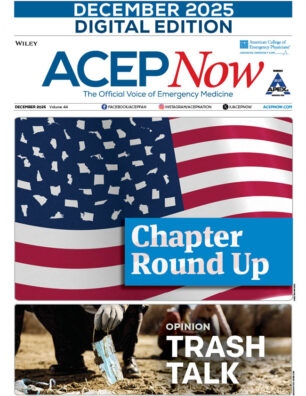Editor’s Note: Read Dr. Cedric Dark’s commentary on this EMRA + PolicyRx Health Policy Journal Club article.
Explore This Issue
ACEP Now: Vol 40 – No 11 – November 2021Emergency departments were created to handle, well, emergencies. However, the emergency department has evolved from a high-acuity-only environment to a critically necessary safety net for the American health care system. This safety net handles all acute needs, regardless of the severity of the issue or the patient’s ability to pay. And despite the breadth of acuity, emergency department visits continue to be universally expensive.1 This has propelled private and public insurers to funnel low-acuity needs to lower-cost alternatives, such as telemedicine and urgent care centers.
Have these efforts been successful in reducing costs? This is the question asked by Wang et al in their retrospective cohort study.2
Wang and his team gathered impressively expansive data, analyzing the claims of approximately 20 million nonelderly patients per year covered by a national managed care plan from Jan. 1, 2008, to Dec. 31, 2019. Their data spanned all 50 states and every type of insurance, including high-deductible, HMO, and PPO. To mitigate confounding data, only previously defined low-acuity conditions frequently seen at urgent care centers (such as rash, muscle strain, bronchitis, and urinary tract infection) were compared. Grouping patients by ZIP code, this study aimed to estimate the proportionate decrease in low-acuity ED visits associated with an increase in urgent care visits. ZIP codes were classified as having no urgent care use, intermediate urgent care use, or high urgent care use.
The study found there was an obvious decline in low-acuity ED visits in ZIP codes that introduced a high-volume urgent care, dropping from 82 visits to 50 (a 39 percent decline). However, even in ZIP codes with no urgent care, low-acuity emergency room usage dropped from 110 to 76 visits (a 31 percent decline). An increase in 37 urgent care visits per enrollee was associated with a decrease of only a single low-acuity ED visit.
This ratio is particularly unsettling when you consider that emergency department visits cost an average of 10 times more than urgent care visits.3 The authors thus predicted that each $1,646 low-acuity ED visit prevented was offset by a $6,327 increase in urgent care center costs—an overall net increase in spending!
A multipronged effort has been pushed by health policymakers, practitioners, and private and public payers to curb low-acuity, high-cost ED visits. Wang et al indicate that utilizing urgent cares to this end has potential but appears financially ineffectual at its current stage.
\There is an obvious need to change the way we treat patients with low-acuity ailments without compromising quality of care or drastically increasing cost of care. Although the increased access to unscheduled acute care that urgent care centers have created is a step in the right direction, there is an obvious need for innovative models of delivery that can increase this access without increasing the cost patients and insurers must shoulder—costs that inevitably are passed on to patients.
This Health Policy Journal Club review is a collaboration between Policy Prescriptions and the Emergency Medicine Residents’ Association.
References
- Moore BJ, Liang L. Costs of emergency department visits in the United States, 2017. Agency for Healthcare Research and Quality website. Available at: https://www.hcup-us.ahrq.gov/reports/statbriefs/sb268-ED-Costs-2017.jsp. Accessed Oct. 18, 2021.
- Wang B, Mehrotra A, Friedman AB. Urgent care centers deter some emergency department visits but, on net, increase spending. Health Aff (Millwood). 2021;40(4):587-595.
- Ho V, Metcalfe L, Dark C, et al. Comparing utilization and costs of care in freestanding emergency departments, hospital emergency departments, and urgent care centers. Ann Emerg Med. 2017;70(6):846-857.
Dr. Rushton is currently a third-year resident in emergency medicine at Spectrum Health/Michigan State University in Grand Rapids.
Pages: 1 2 | Multi-Page





No Responses to “New Study Analyzed Effects of Increasing Urgent Care Capacity”